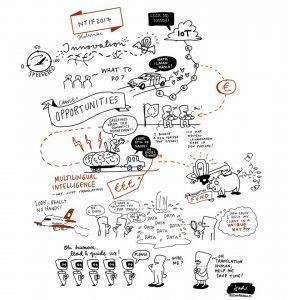Nordic Translation Industry Forum #NTIF2017 was held in Helsinki. Thank you for bringing it over, A-M and Cecilia! I was a newbie, meaning this was my first time to attend NTIF. The conference is targeted at the agency side of the industry, but its program did offer a bit of something for everybody. The best part, as always, was meeting colleagues from the other Nordic countries. We’ll definitely keep in touch and hopefully meet again next year at either NTIF or another language service conference. There are many alternatives these days. Language services are a growth sector in the global economy.
Slanting towards the communication side of the industry, I was happy to find Katleena Kortesuo’s take on crisis communication on the agenda. The reactions of the public and the media to celebrities and companies are actually rather predictable if we consider three classic scenarios: the Cinderella story, David vs. Goliath, and Icarus. Her advice was to play the role of either Cinderella or David to promote one’s image and prevent crises that require crisis communication. The story would thereby lead from rags to riches, root for the average person against a giant, or anticipate the fall of an overly applauded individual. If a crisis occurs, you need to recognize in which of these stories you’re playing and what is your role. It’s better not to try and change the role but rather try and change the story. Being a martyr is not a good idea: let someone else talk for you, a mediator or a Godmother. Remember that there must be a villain in every story, and this time it might be you. These basic storytelling rules apply to almost any culture and language, although in the US, being a Goliath may be considered a positive trait at first.
Automation is one of the key themes in the industry. We’re constantly asking ourselves when machine translation is going to work as well as human translation and expecting to transmit powerful messages in any language with the help of simultaneous interpretation and digital platforms. Tarja Karjalainen of Polar recommended automating everything *around* translation because creative work cannot be automated. Designing content so that it is easy to localize is another way to improve efficiency, and in the context of software localization, an agile versus the waterfall method of development. One more thing that will make text workers’ lives easier is speech recognition. I am a loyal user of memoQ translation memory software, and I was happy to meet their representatives at NTIF and remind these inventive Hungarians of my need for context-sensitive speech-to-text functionality.
Interpretation services are developing fast towards digital, human-involving, solutions. Six of them were introduced at NTIF2017, and after a vote among the audience, Finnish Tulka was selected a winner. In an ideal situation, you download an app on your mobile phone, select the language pair needed, and immediately receive professional interpretation service 24/7. People need immediate interpretation services now more than ever. Remote systems are being created to bring them closer. They are particularly necessary and useful when dealing with authorities or medical care in a foreign culture.
Leena Peltomaa of AAC Global addressed quality control and review processes from an agency point of view. She confirmed what is clear to many of us professionals based on years of experience: quality is a team effort. Quality issues usually arise not due to actual translation errors but because of preferential changes. Dialog with the client and expectation management are a must. Before the assignment, it’s a good idea to define and agree on the quality factors, quality levels as well as the reviewer’s role, and to communicate these to all stakeholders. Quality without further specification can mean anything, so satisfaction is also very much about trust among the language service provider and the client.
 What people need is communication across cultures, not translation, said Henrik Lottrup of LanguageWire. That is essential to keep in mind both when ordering or providing language services. Untypically for a growth sector, only 20 per cent of the 40-billion-dollar industry is in the hands of big agencies. This means that 80 per cent of LSPs are SMEs or freelancers. A huge opportunity for startups and a clear sign of stiff competition to expect on the market! The NITF2017 Innovation Panel emphasized that changing nothing is a risk. The internet of things and application platforms are bound to bring more work for translators and writers. We’ll be expected to provide traditional service while renewing the service design and to think in a more modular way. In the future, 85 per cent of all information will be in video format, and the need for speech-to-text software development will increase due to time limits. Soon it will be more profitable to sell multilingual intelligence and semantic units instead of translation.
What people need is communication across cultures, not translation, said Henrik Lottrup of LanguageWire. That is essential to keep in mind both when ordering or providing language services. Untypically for a growth sector, only 20 per cent of the 40-billion-dollar industry is in the hands of big agencies. This means that 80 per cent of LSPs are SMEs or freelancers. A huge opportunity for startups and a clear sign of stiff competition to expect on the market! The NITF2017 Innovation Panel emphasized that changing nothing is a risk. The internet of things and application platforms are bound to bring more work for translators and writers. We’ll be expected to provide traditional service while renewing the service design and to think in a more modular way. In the future, 85 per cent of all information will be in video format, and the need for speech-to-text software development will increase due to time limits. Soon it will be more profitable to sell multilingual intelligence and semantic units instead of translation.
See full program on the NTIF website here. Illustration based on sketchnoting by Linda at Redanredan.